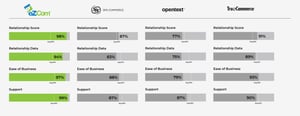Meeting retailer EDI standards.
As your revenues grow, your retail footprint usually expands. That’s typically good news—more outlets should mean more sales. Products will be more widespread, and brand awareness increases as you reach new audiences.
Along the way, you’ll encounter some demanding retailer compliance standards. As frustrating as they can be, it’s also fair to note that retailing isn’t exactly an easy business these days. Margins are tight, affordable real estate is a challenge, consumers are fickle—it’s hard to fault stores for taking steps to ensure their supply chains are as efficient as possible. It only takes a quick scan of business news to see the demise of former juggernauts—Forever 21, Toys R Us, even CVS is closing stores next year—and realize that nothing can be taken for granted in today’s hyper-competitive retail landscape.
Of course, that’s small comfort when you’re faced with paying a chargeback because your order did not match the standards of the retailer. Or dealing with the expense of returned merchandise because of miscommunication or an administrative error. Rack up enough of these mistakes and you’ll start to wonder if the cost of doing business with some retailers is worth the effort.
Maybe you have decided chargebacks are an inevitable cost of doing business. Trust us—it doesn’t have to be that way. Here are six steps that will help you build relationships and work flows that prevent expensive mistakes.
Step #1: Start off on the right foot when you add a new retailer.
Retailers want to do business with brands they are confident will be consistent, accurate, and reliable. When you begin working with a new retailer, make every effort to ensure that your first transactions are error-free—they can set the tone for the future relationship. Many will ask you to complete EDI testing—a knowledgeable, expert EDI provider can help you navigate this phase successfully. Once you begin trading, make sure your EDI company has completed the necessary mapping for the retailer. Bottom line: you only get one chance to make a first impression. Work with someone who can help you make it a good one.
Step #2: Make sure your EDI and order management software is tailored for your company.
An off-the-rack software solution will probably fit your company about as well as a cheap polyester suit. After all, every business is different and your EDI application should reflect that.
Without the ability to customize your solution, you wind up using workarounds that increase the chance of error. Or your staff members elect to follow a process of their own creation, resulting in confusion, uneven work flow, and a lack of consistency.
When your software can be tailored for your specific needs, it is adopted easily by your organization and will function well with your trading partners. What’s more, ask about the customer support that’s behind the application. Even the most thoughtful software needs experts who can help you quickly resolve issues.
Step #3: Take the time to identify chargeback issues and tackle the EDI errors causing them.
Before you can fix a chargeback problem, you need to find out exactly what’s causing it. Chances are, if you’re dealing with issues when working with a retailer, many of them have the same root cause. Working with an expert EDI software provider should help you avoid most of them. Here are some of the most common reasons suppliers end up dealing with the sting of a chargeback:
- You sent an incorrect or incomplete Advance Ship Notice (ASN or EDI 856). You can also face a chargeback if the ASN doesn’t arrive—but the delivery does.
- You missed the delivery window. In this era of Just-in-Time shipping, an order that arrives too late or too early is a problem. You need to deliver within those windows, and sometimes they are tight.
- You failed to communicate the receipt of a Purchase Order (850/875) with a Functional Acknowledgment (997). Or you missed the window for sending the 997.
- You shipped packages without the correct inner and outer pack quantities.
- You missed some important details. UPC codes, pedigrees, serial numbers or lot IDs were not properly traced or embedded in product labels.
- You sent the packing slip in the wrong format. Ugh.
- Your retailer-specific GS1 barcode label failed to provide required data.
- The routing instructions were not followed exactly.
- Your invoice documents (810/888) bounced back because they were incomplete or missing required information. Nothing worse than making an error on the document that gets you paid.
Step #4: Know your retail trading partners.
Make sure you have consistent communication with your trading partners. Rather than ignore a problem, tackle it head-on to find out if the issue is systemic or a one-off. Once you have established that, go forward with a plan that will prevent problems in the future. If you’re working with an expert, experienced EDI provider, they should be able to both keep you compliant and quickly address any issues.
Step #5: Always keep improving your EDI and order management.
EDI compliance is an ongoing process. Improvement needs to be a part of that.
As you begin to work with new retailers, use the experience you have gained to inform your path forward. That will help you avoid issues that may have led to chargebacks in the past.
You should also be tracking your success. Is the ratio of chargebacks to transactions improving? Is there a certain retailer that is challenging for you? Are you getting repeated chargebacks for the same error? When you track it, you can fix it.
Step #6: Examine your EDI software provider.
There are many cloud-based, SaaS software solutions you can use to complete EDI transactions. Choosing the one that suits your company and its evolving needs will make a big difference.
Many EDI software providers offer out-of-the-box solutions. Here at eZCom, we’ve been working in EDI and order management since 2000, and we understand the need to customize our application for different companies. While the powerful engine behind our software remains the same, we examine the work flow of our clients to tailor our application and optimize the process. When it makes sense, we expertly integrate our Lingo software—ERPs like NetSuite, accounting software like QuickBooks, a 3PL, a WMS—to make EDI and order management a seamless part of your operation.
Chargebacks are just about the most painful outcome of an EDI transaction. But with some investigation and research, you can have a seamless process and avoid costly mistakes.





